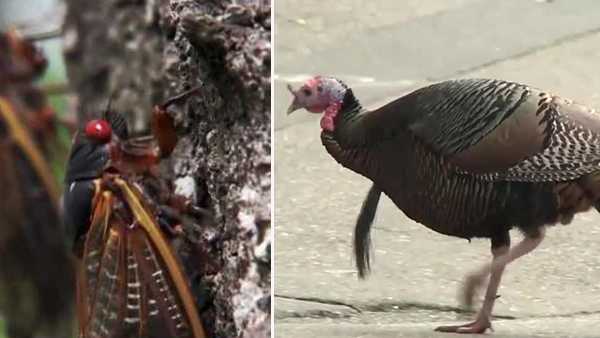
Here's why cicadas are expected to cause a wild turkey boom in Kentucky
Cicadas and wild turkeys — not your average ecological match-up per se, but you might be surprised to learn that cicadas could help the struggling turkey population in Kentucky.Kentucky Fish and Wildlife Turkey Biologist Zak Danks said Kentucky's last major cicada brood in 2008 led to a record-setting year for turkey reproduction. (Note — this was a different cicada brood than the one re-emerging now.) That year, Danks said wild turkey reproduction saw a 95% jump, which led to a record harvest of 36,000 turkeys two years later. The previous record was 30,000 turkeys. "Cicadas are a great source of protein for turkeys and their predators," Danks explained. "When the turkeys eat the cicadas, they don’t have to move and search for food, so they're not exposed to the predators either — plus the predators eat the cicadas, too, so it's really a triple-win for turkeys."Danks said in recent years, hunters have noticed a decline in the turkey population, and says bad weather and a wide variety of predators are both to blame."We think turkeys really struggle to reproduce. They're important culturally, ecologically, and to hunters," which Danks said is vital to the survival of Kentucky Fish and Wildlife. "We hope that they have a chance to pursue them because hunters pay for conservation in this state. The department gets zero general fund tax dollars. We're funded through fish and hunting licenses and federal matching grants."Danks expects Kentucky to see pockets of cicadas pop up this year, but says the next big boom in the Commonwealth will be 2025. "When Brood XIV (14) emerges, that's when we expect the eastern two-thirds of Kentucky will see a boom in turkey colts and hopefully we can see that reflected in 2027," he said.
Cicadas and wild turkeys — not your average ecological match-up per se, but you might be surprised to learn that cicadas could help the struggling turkey population in Kentucky.
Kentucky Fish and Wildlife Turkey Biologist Zak Danks said Kentucky's last major cicada brood in 2008 led to a record-setting year for turkey reproduction. (Note — this was a different cicada brood than the one re-emerging now.)
That year, Danks said wild turkey reproduction saw a 95% jump, which led to a record harvest of 36,000 turkeys two years later. The previous record was 30,000 turkeys.
"Cicadas are a great source of protein for turkeys and their predators," Danks explained. "When the turkeys eat the cicadas, they don’t have to move and search for food, so they're not exposed to the predators either — plus the predators eat the cicadas, too, so it's really a triple-win for turkeys."
Danks said in recent years, hunters have noticed a decline in the turkey population, and says bad weather and a wide variety of predators are both to blame.
"We think turkeys really struggle to reproduce. They're important culturally, ecologically, and to hunters," which Danks said is vital to the survival of Kentucky Fish and Wildlife. "We hope that they have a chance to pursue them because hunters pay for conservation in this state. The department gets zero general fund tax dollars. We're funded through fish and hunting licenses and federal matching grants."
Danks expects Kentucky to see pockets of cicadas pop up this year, but says the next big boom in the Commonwealth will be 2025. "When Brood XIV (14) emerges, that's when we expect the eastern two-thirds of Kentucky will see a boom in turkey colts and hopefully we can see that reflected in 2027," he said.
Source link









